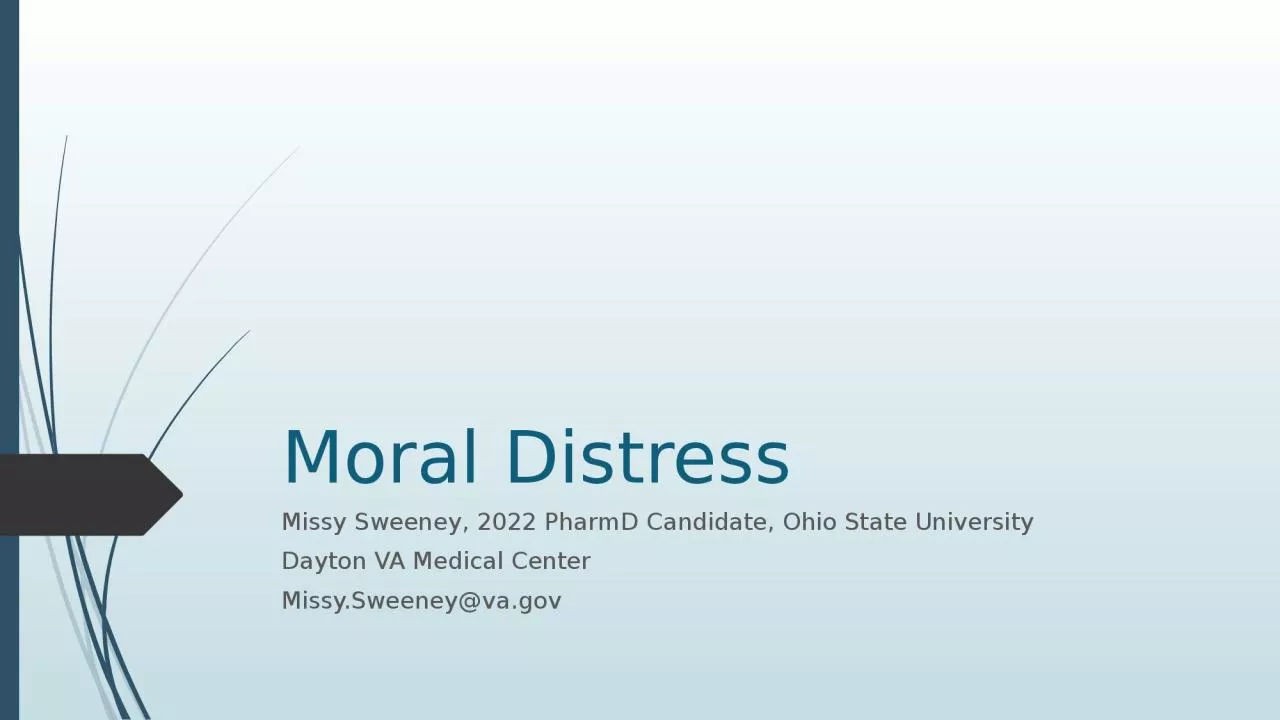

Dayton VA Medical Center MissySweeney va gov Objectives To define what moral distress is To recognize signs and symptoms of moral distress To identify contributing factors to moral distress ID: 1039933
Download Presentation The PPT/PDF document "Moral Distress Missy Sweeney, 2022 Pharm..." is the property of its rightful owner. Permission is granted to download and print the materials on this web site for personal, non-commercial use only, and to display it on your personal computer provided you do not modify the materials and that you retain all copyright notices contained in the materials. By downloading content from our website, you accept the terms of this agreement.
1. Moral DistressMissy Sweeney, 2022 PharmD Candidate, Ohio State UniversityDayton VA Medical CenterMissy.Sweeney@va.gov
2. ObjectivesTo define what moral distress is To recognize signs and symptoms of moral distressTo identify contributing factors to moral distressTo understand potential methods to combat moral distress
3. Moral Distress Defined1,4,6Originally defined as, “the mental and emotional distress an individual experiences from knowing what to do in an ethical situation, but not being able to carry it out due to institutional constraints” – Andrew Jameton, 1984Moral distress is the emotional or physical state which results from a situation where a healthcare provider determines an action they consider to be “ethically correct” but are unable to carry out. There is a sense of betrayal to their moral integrity.
4. Prevalence5-7
5. Symptoms of Moral Distress2-5PhysicalFatigueLethargyImpaired SleepExhaustionEmotionalAngerFear/AnxietyGuiltConfusionBehavioralApathyControlling behaviorApathyDepersonalizationSpiritualDisconnection from othersCrisis of faithLoss of controlLoss of meaning
6. Significance2,3,6,9Often results in providers leaving their jobs, experiencing moral residue, or feeling burnt outFeelings of anger, guilt, or frustration from moral distress may lead nurses to avoid patientsInadequate or inappropriate care of patients could lead to increased pain, patient dissatisfaction, and longer hospital staysPrevents patients and their families from receiving the support and care they need, leading to worsening outcomes
7. ContributingFactors3,4,6,7Internal FactorsLack of assertivenessSelf-doubtPerceived powerlessnessFear of retaliation External FactorsLack of teamworkInsufficient staffPolicies or proceduresPatient or family demandsA breakdown in communication and support was a recurring, significant factor amongst multiple studies
8. Proposed theory impact from Nurse Moral Distress: A Proposed Theory and Research Agenda3
9. Strategies to Overcome Moral DistressMoral Courage3“Willingness to take a controversial stand or one that challenges the health care organization or those in it, even when a person’s job may be jeopardized”By utilizing moral courage, a provider may feel less moral distress from an ethical situation because they know they attempted to do what they believed to be morally justMoral Resilience4“An individual’s ability to develop effective coping strategies, create meaning, and minimize moral distress in the face of challenging ethical work”An adaptation to moral distress which involves recognizing difficult ethical scenarios and mindfully overcoming the dilemma
10. Strategies to Overcome Moral Distress (cont.)Use of the Moral Distress Map10 – A tool to be used in combination with active listening and empathyProviders respond with emotions they were feeling during a morally distressing event which opens up a conversationHelps all involved recognize what may have contributed to the morally distressing event which helps identify where improvements could be targetedProviders list constraints (internal and external) which kept the provider from doing what they believed to be morally correct Providers define what obligation conflicted with a specific moral responsibilityProviders then brainstorm possible actions they could take to improve outcomes for patients and their families, along with coping mechanisms.A final action is agreed upon which may best address or prevent moral distress in various scenarios
11. Strategies to Overcome Moral Distress (cont.)
12. Strategies to Overcome Moral Distress (cont.)Implementation of Healthy Work Environments3,7,11 Fostering a supportive environmentProviding a safe, nonjudgmental space for providers to open upPromoting an interprofessional team who can communicate freely and frequently about goals of care to work consistently and collaboratively toward a consensusDecreases inappropriate treatment, increases information exchangeHave adequate staffingCan define clear roles amongst different team members and can enable them to adequately perform their rolesCan prevent feelings which may augment effects of moral distress (resentment, burnt out, rushed)
13. Final Thoughts
14. Questions?
15. ResourcesJameton A. Nursing Practice: The Ethical Issues. Englewood Cliffs, NJ: Prentice-Hall; 1984Savel RH, Munro CL. Moral Distress, Moral Courage. AJCC. 2015; 24(4): 276-278. doi:10.4037.Corley, MC. Nurse Moral Distress: A Proposed Theory and Research Agenda. Nursing Ethics. 2002; 9(6): 636-650. doi:10.1191.Helmers A, Dryden Palmer K, Greenber RA. Moral Distress: Developing strategies from experience. Nursing Ethics. 2020; 27(4): 1147-1156. doi:10.1177.Oh Y, Gastmans C. Moral distress experienced by nurses: A quantitative literature review. Nursing Ethics. 2015; 22(1): 15-31. doi: 10.1177. Whitehead PB, Herbertson RK, Hamric AB, et al. Moral Distress Among Healthcare Professionals: Report of an Institution-Wide SurveyPavlish CL, Brown-Saltzman K, Raho J, et al. A National Survey on Moral Obligations in Critical Care. AJCC. 2019; 28(3): 183-192. doi: 10.4037.Wilkinson JM. Moral Distress in nursing practice: experience and effect. Nurse Forum. 1987; 23(1): 16-29. Baggs JG, Smitt MH, Mushlin AI, et al. Association between nurse-physician collaboration and patient outcomes in three intensive care units. Crit Care Med. 1999; 27: 1991-98.Dudzinski DM. Navigating moral distress using the moral distress map. J Med Ethics.2016; 42: 321-324.Pavlish CL, Henriksen J, Brown-Saltzman K, Robinson EM, et al. A Team-Based Early Action Protocol to Address Ethical Concerns in the Intensive Care Unit. AJCC. 2020; 29(1): 49-61.